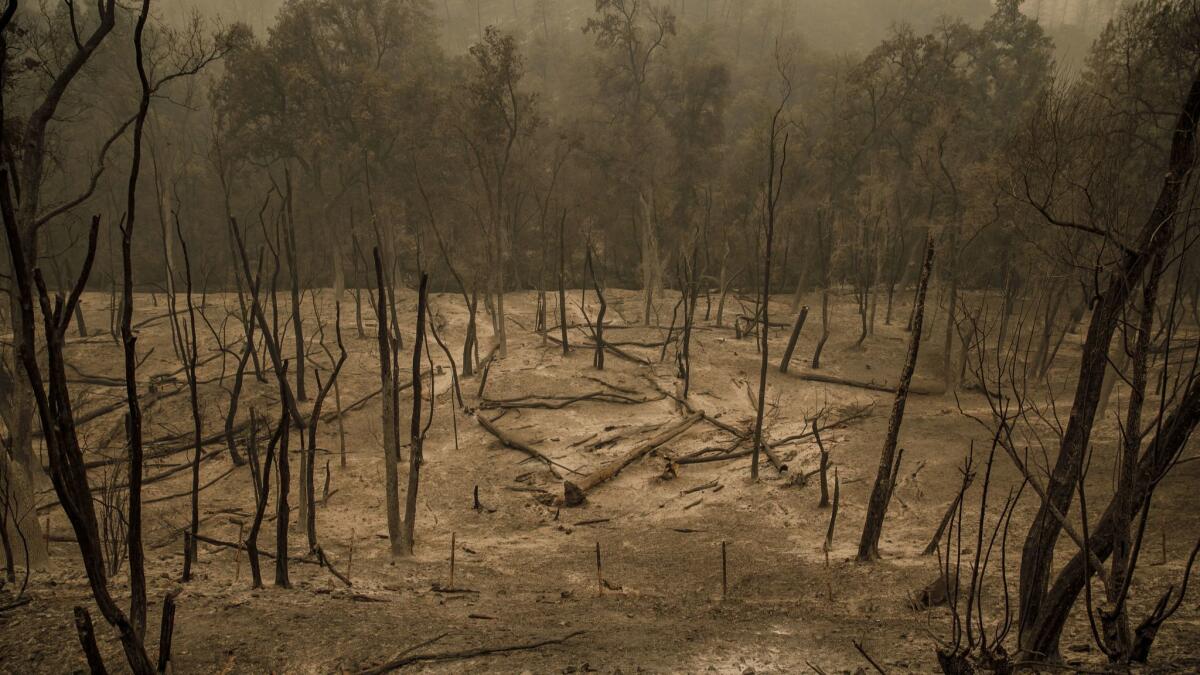6 things you can do to protect wildfire-scorched yards from the rains

- Share via
Now that homeowners in wildfire zones are returning to their properties, a new battle begins: protecting their precious topsoil before the winter rains begin.
The likelihood of runoff and erosion doubles after fires in urbanized areas, because recently scorched soils become hydrophobic, meaning they repel water.
Fires cook the waxes that are natural to our soils. When these waxes cool, they coat the first inch of soil with a repellent layer, stopping water from infiltrating.
So when the rains come, instead of soaking into the ground, the water streams over the top, jamming stormwater drainage systems with mud and debris and sending torrents of runoff into yards, streets and even homes, as with the devastating mudslides after the Thomas fire in Montecito that killed 21 in January.
Although most soils lose their repellency within a year, some may stay hydrophobic for up to six years, depending on the fire’s intensity and the size of a soil’s particles.
Resist the urge to dump mulch on the property, however. It won’t stop erosion, but it will stifle the new growth of weeds and other seeds that are crucial to holding the damaged soil in place.
We need to hold our ground, so try to shrug off the fire fatigue and do these six things as soon as you can:
Dampen your soil
A little sprinkle can help break the repellent layer. This first watering should be super light — use a fine spray to dampen only the top quarter-inch of the soil. Once the soil starts absorbing those little showers, begin deeper waterings. The goal is to get the water 4 inches deep and encourage seeds, roots and surviving plants to sprout. Water again only when the first 2 inches have dried.
Break out the hoes
If the soil continues to shed water after multiple light waterings, it’s time to get physical. Grass rakes, hoes, even Hula-Ho weeders can be lightly dragged across the top of the soil to break up the barrier.
Clear drainage systems immediately
Water pouring out of culverts or drains is a leading cause of erosion, and fires tend to fill gutters, culverts and streams with lots of debris, so your first priority should be clearing all stormwater drainage systems, including roof gutters.
Dig a ditch or fill a sandbag
Driveways, roadways, sidewalks and parking lots are often designed to “sheet” their water runoff into landscaped areas, but after a fire, those soils won’t be able to handle the load. Instead, use sandbags, diversion ditches (a.k.a. swales) or other materials to divert runoff from hardscape areas to your cleaned-lout drainage systems. Check out these instructions for diverting “sheeting” water.
Tread lightly — or not at all
Stay on what remains of your garden paths, and keep feet and equipment off the rest of the property as much as possible. Activity on flat ground can compact the soil and lower its water absorption rates, which further destabilizes the soils on slopes. Postpone working on an injured ground until a restoration plan has been developed and all the materials are ready for use.
Leave the mess for now
As tempting as it may be, do not clean your landscape. The charred remnants of plants and whatever else the fire left behind protect against erosion, slow runoff and provide a sad kind of mulch, to keep surviving seeds and plants from drying out. So postpone any cleanup until you’re ready to begin restoration.
To find out more about fire-damaged soil, or to check a property’s chances for erosion and topsoil loss, visit www.anfractus.com.
Kent is the author of “Firescaping: Creating Fire-Resistant Landscapes, Gardens, and Properties in California’s Diverse Environments.” He teaches land management classes at Cal Poly Pomona.
More to Read
Sign up for The Wild
We’ll help you find the best places to hike, bike and run, as well as the perfect silent spots for meditation and yoga.
You may occasionally receive promotional content from the Los Angeles Times.











